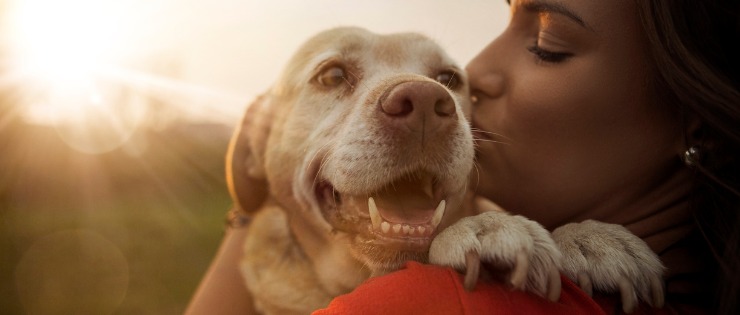
Just as some people suffer anxiety, so do our furry friends. Many of us have nervous habits, and so do our dogs.
Canine anxiety can be easy to spot when you know the signs. There are several traits that owners should look out for that can tell us our dog is stressed or anxious. But not all the traits are exclusive to being anxious. It’s a matter of looking out for the signs when your dog is in a situation you think may cause him anxiety. It doesn’t take long to see a pattern of behaviour emerge then taking action.
How Do You Know if Your Dog has Anxiety? - 7 Signs of an Anxious Dog
Check out the list of behaviour traits that could be a sign of an anxious dog.
#1 Yawning
Your yawning dog might be tired or bored, but excessive yawning can be a sign that they’re anxious. When you see your dog yawn, consider the environment and the possibility that something is causing them to feel stressed or anxious.
#2 Shaking
Shaking is part of the fight-or-flight response to a threat. The increased cortisol causes a range of reactions in the body, including increased respiratory and heart rate, dilated pupils, slowed digestion and shaking. The shaking can take on different forms in different dogs. Some anxious dogs will intermittently shake their coat as if it’s wet, while other dogs will tremble.
Your dogs shaking may not be because of anxiety. Shaking can also be triggered by medications, pain, illness or excitement.
#3 Changed Behaviour
If your dog isn’t usually destructive but starts chewing up shoes or destroying the furniture when you leave them alone, it may have anxiety, not naughty behaviour. Chewing can be a sign that they’re suffering from separation anxiety. Your dog could also be bored left at home on his own. You can try leaving behind a Kong stuffed with treats that they have to work for or frozen treats in summer.

Another common idea for reducing boredom is to wear them out before you leave the house. Change your routine, so you walk them in the morning or play a game of hide and seek or tug of war. If this isn’t possible, organise a dog walker to come in during the day or drop him off at doggy daycare or to a family member.
A previously toilet-trained dog may have accidents in the house because of anxiety. It may be noise or a perceived threat in the backyard that’s causing your dog to be too anxious to do their business outside.
#4 Panting
When a dog is hot or has been exercising, they pant to cool down. Unlike humans, dogs can’t sweat to cool themselves, so they pant. But a stressed or anxious dog may also pant without the need to cool down. Drooling may also accompany the panting as a sign of their anxiety.
#5 Licking Lips or Sneezing
If it’s time for tea and your dog is telling you they’re hungry or they’re eying off your steak, they will probably lick their lips. But if it’s outside meal time, their lick lipping can be a sign of anxiety.
Your dog might sneeze when they come into contact with a strong smell, but they may also be anxious. In addition to sneezing, a dog may cough as a way of releasing the built-up stress they’re feeling.
#6 Restlessness
When a dog paces or moves around more than usual, it can be a sign they’re anxious. If your dog doesn’t settle or relax, they might be pacing to relieve their anxiousness. Something or someone in their home could cause them to feel anxious. Some dogs use pacing to get their owner’s attention. Your dog may also have an underlying medical issue that's causing the pacing, so if it’s not anxiety, take your dog to the vet.
#7 Eyes and Ears
Just as in people, canine anxiety can show in their faces. An anxious dog may have dilated pupils or blink rapidly. Their eyes may be wide open and show more of the white part of their eyes than usual. A dog’s ears may sit flat, like they’re pinned back against their head.
Being familiar with how your dog looks when they’re relaxed and happy can help with noticing small facial signs of anxiety.
Causes of Anxiety in Dogs
All dog breeds can be affected by anxiety. There are four major causes of anxiety – situational, separation, aging, social and illness related.
Situational Anxiety
Fear-related anxiety can be caused by many situations. For some dogs it’s loud noises, a new environment (or one they know too well like the vet or grooming shop), unfamiliar people, umbrellas, floor coverings…almost anything can cause anxiety in a dog.
Separation Anxiety
Dogs are social animals, and plenty of dogs don’t like being left alone. Many dogs have become used to their owners working from home and struggle when they’re by themselves. The boredom or loneliness they experienced on a previous occasion can trigger separation anxiety on future occasions.
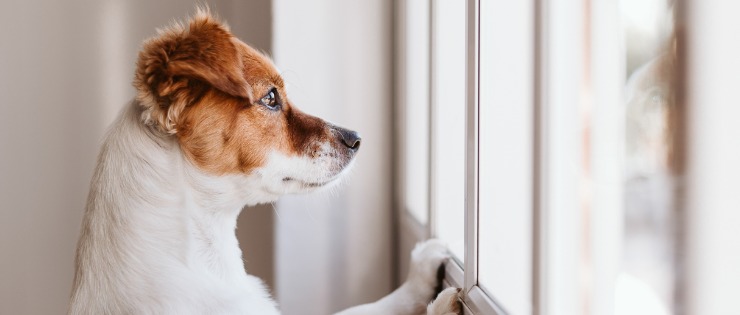
Age-Related Anxiety
Just like humans, dogs can suffer from cognitive dysfunction later in life. Their memory may start to go; perception and awareness decline, which leads to anxiety and confusion in older dogs.
Social Anxiety
A dog may be anxious around some people or other dogs. Their anxiety can relate to a past trauma or a bad experience. Even if a dog is socialised at a young age, they may still suffer from anxiety in some situations.
Illness-Related
A dog that develops signs of anxiety or fear suddenly or later in life may have an illness or disease rather than anxiety. Always have your vet check out your dog if you notice a change in behaviour. Some of the most common illnesses include hearing or vision loss, pre-diabetes, encephalitis, or hyperthyroidism.
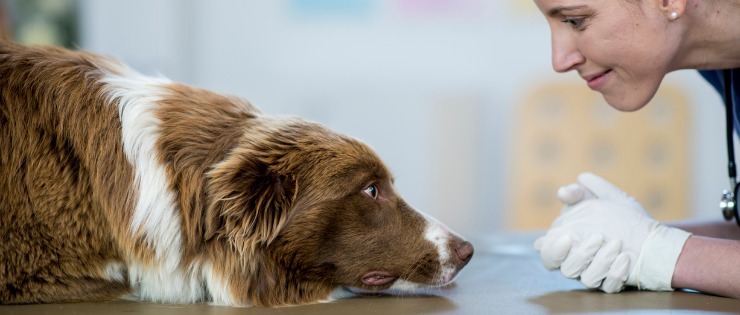
Which Dog Breeds are Most Affected by Anxiety?
Anxiety can affect dogs of all shapes and sizes, but it seems some dog breeds suffer from general and separation anxiety more than others. Experts think these breeds suffer the most because they crave human companionship or they’re working dogs that need physical and mental stimulation throughout the day.
The following breeds are most likely to suffer from anxiety:
The Importance of Knowing the Signs of Anxiety in Dogs
Many dog owners don’t recognise anxiety in their dog, so they don’t take any action. But anxiety can lead to aggressive, dangerous behaviour in dogs.
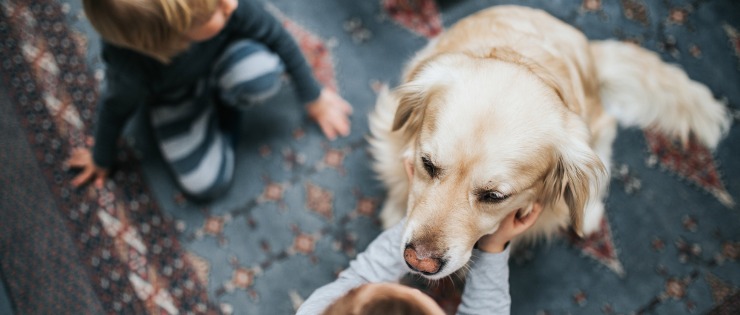
Stay Vigilant Around Young Children
Some dogs aren’t as comfortable around some people as they are with others. It’s important to know if your dog is anxious in the company of small children. Kids can make a dog feel anxious because their behaviour is unpredictable. Dogs know kids are more likely to pull their tail, sit on them, or wrap themselves around their neck compared to an adult.
One day the anxiety may become too much for a dog and they could bite or nip a child. It’s for this reason that we should never leave small children unattended with dogs, even the family pet. You should never completely trust that your dog won’t hurt a child. While supervising your dog and a child in the same room together, look for signs of anxiety in your dog. If you think your dog is anxious, separate them immediately. You’re protecting the child and your dog.
Offer Reassurance to Your Dog
If you recognise the signs and think your dog is suffering anxiety, you can make modifications to the environment or reassure your dog. Your dog may not like being near another dog or person, so you can take them to another area.
Your dog may be anxious when a new person comes into the house. You can reassure your dog with a pat, encouraging words or give them a treat, so they associate an unknown visitor with something positive. Just giving your dog a regular command like ‘sit’ or ‘down’ can reassure a dog. Routine commands act as a distraction and provide a sense of normalcy.
Treatment for a Dog’s Anxiety
If you don’t know your dog is anxious, you can’t provide any treatment and with no treatment your dog may not enjoy the best possible quality of life.
Available Treatment Methods
Most cases of anxiety in dogs are mild however, there are dogs that require treatment for their anxious behaviour. Treatment can make their life (and yours) a little easier!
There are several methods of treatment you can try.
Medications
Vets have the option of prescribing medications for dogs with anxiety disorders. There are several to choose from and some medications you’ll recognise as those taken by humans – Xanax, Prozac, Valium and Zoloft.
The medication chosen will depend on the severity of the dog’s anxiety and the cause. For example, one medication is better than another for separation anxiety, thunderstorms and general anxiety.
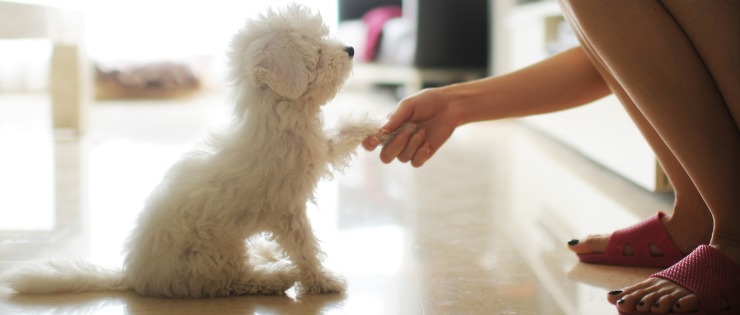
Training
Some dogs can be trained to reduce the symptoms of anxiety. Counter conditioning changes the way your dog responds to the stimuli that cause anxiety. The training focuses on changing the anxious behaviour into desirable behaviour using a dog toy or treat. Some owners can use a desensitising method where the cause of the anxiety is introduced in small doses. With time, the doses are increased to a point where it no longer induces anxiety in the dog.
It’s rarely easy training out of their anxious ways, so you may need the help of a professional dog trainer.
Pheromone Hormone Products
For owners wanting to avoid drug treatments, they might try pet pheromone products. The calming or appeasing pheromones can work in dogs with general anxiety, or situational anxiety like visiting the vet. The pheromones are available as sprays, diffusers, wipes, and collars.
Safe Place
Your dog may appreciate a safe place they can go when they’re feeling anxious. When a new person arrives at the house or there’s a loud noise, they may feel reassured by being able to retreat to their kennel, under a bed or behind a couch for safety.
Exercise
Just like humans, we can relieve canine anxiety with exercise. Getting out in nature for a walk or run can do wonders. The hit of cortisol can make your dog feel better and act as a circuit breaker to the anxiety they’re feeling.
Prevention is Better Than a Cure
When you took home your cute puppy, their mental health probably wasn’t your biggest concern. You were busy with house training, feeding and stopping those sharp puppy bites. Some dogs are born anxious because of genetics, while an anxiety disorder can develop in others.
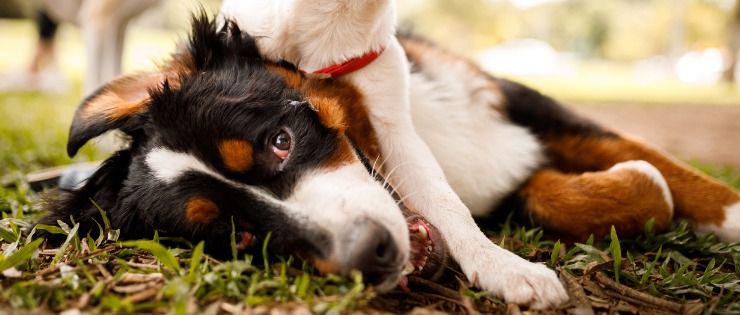
Socialisation
If your dog is showing signs of anxiety, this tip is no doubt too late for your pet. It’s important to socialise your pup with people and other dogs during the first 4-16 weeks of life. This is when their brain is most active in learning about other dogs, animals and people. Puppy school is a great way for them to socialise in a safe environment before they’re fully vaccinated.
Training
Early training sets up the relationship between dog and owner. Obedience training as a pup can lay the groundwork for training later on to control unwanted behaviour like barking. But you can start training at any age to change your dog’s behaviour and help reassure an anxious dog.
If you have any concerns about your dog’s behaviour, speak to your vet today